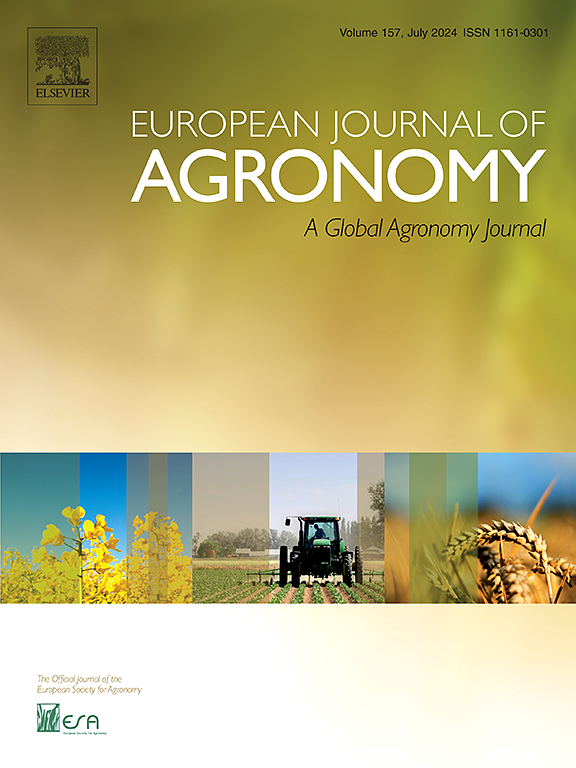玉米产量模拟DSSAT和APEX模型的自动标定及经济最优施氮量测定
IF 5.5
1区 农林科学
Q1 AGRONOMY
引用次数: 0
摘要
多种作物生长模型被用于模拟不同因素对作物产量的影响,并支持农民优化作物管理。然而,在这些模型的实际应用中,准确和有效的校准是一个具有挑战性和关键的步骤。本研究的目的是:1)评估一种自动模型校准策略;2)比较DSSAT和APEX模型对不同施氮量下玉米生长、植株氮素吸收和产量的模拟效果,并估算经济最优施氮量(EONR)。本研究使用了2014年至2016年在美国明尼苏达州和威斯康星州进行的8个站点年的N实验的详细数据。用回归模型拟合观测和模拟玉米产量对施氮量的响应。结果表明,DSSAT和APEX模型在明尼苏达州的玉米产量模拟中表现良好,人工校准的R²为0.78-0.95,均方根误差(RMSE)为0.2-1.4 t ha⁻¹ ,归一化均方根误差(NRMSE)为2 % -17 %。使用与模型无关的数据同化(MIDA)优化器自动校准产生了稳健的产量预测结果(R²= 0.66-0.95;RMSE为0.3-1.4 t ha−1,NRMSE为3-17 %)。此外,DSSAT和APEX模型均能较好地模拟不同施氮量和EONR下的产量,尽管在某些样地年存在较大的预测误差。使用威斯康辛州数据的独立检验进一步证实了使用两种校准策略的两种模型的产量预测精度较高(R2: 0.79-0.88)。虽然这两个模型在手动校准时都高估了成熟时的生物量,但使用MIDA优化器的自动校准显着减少了预测误差,特别是对于DSSAT (RMSE: 0.7-3.5 t ha⁻¹;NRMSE: 3 % -17 %)。DSSAT模型能较好地模拟植物成熟期氮素吸收(R²:0.66 ~ 0.92),但APEX模型的R²值较低且变化较大(0.00 ~ 0.91),表明APEX模型对植物成熟期氮素吸收的模拟还有待改进。两种模型对抽雄期生物量和植株氮素吸收的模拟结果存在显著差异。综上所述,基于MIDA优化器的作物生长模型自动标定可以有效地优化作物生长模型参数,降低了局部最优的风险。DSSAT和APEX模型均能较好地模拟玉米产量、产量对氮素的响应和EONR,但APEX模型在模拟生物量和植物氮素吸收方面仍需改进。需要更多的研究来进一步评估在农场条件下校准作物生长模型的自动校准工具,以支持其更广泛的实际应用。本文章由计算机程序翻译,如有差异,请以英文原文为准。
Automatic calibration of DSSAT and APEX models for maize yield simulation and economic optimum nitrogen rate determination
Multiple crop growth models are being used to simulate the impact of different factors on crop yield and support farmers for optimizing crop management. However, accurate and efficient calibration of these models is a challenging and critical step in their practical applications. The objectives of this study were to 1) evaluate an automatic model calibration strategy; and 2) compare the performance of DSSAT and APEX models for simulation of maize (Zea mays L.) growth, plant nitrogen (N) uptake, yield in response to different N application rates and the estimation of the economic optimum N rate (EONR). Detailed data collected from eight site-years of N experiments conducted from 2014 to 2016 in Minnesota and Wisconsin, USA were used in this research. Observed and simulated maize yield responses to N rate were fitted with regression models to estimate the EONR. The results indicated that both DSSAT and APEX models performed well at Minnesota sites in maize yield simulation, with manual calibration achieving R² of 0.78–0.95, root mean square error (RMSE) of 0.2–1.4 t ha⁻¹ , and normalized root mean square error (NRMSE) of 2 %–17 %. Automatic calibration using a model-independent data assimilation (MIDA) optimizer yielded robust yield prediction results (R² = 0.66–0.95; RMSE of 0.3–1.4 t ha−1 , and NRMSE of 3–17 %). In addition, both DSSAT and APEX models performed well in simulating yield at different N rates and EONR for both preplant and split N application scenarios, although high prediction errors were observed at some site-years. The independent test using Wisconsin data further confirmed the high accuracy of yield prediction for both models using the two calibration strategies (R2 : 0.79–0.88). While both models overestimated biomass at maturity during manual calibration, automatic calibration using the MIDA optimizer significantly reduced prediction errors, particularly for DSSAT (RMSE: 0.7–3.5 t ha⁻¹; NRMSE: 3 %–17 %). Plant N uptake at maturity was reasonably well simulated using the DSSAT model (R²: 0.66–0.92), but the APEX model exhibited low and variable R² values (0.00–0.91), highlighting the need to improve plant N uptake simulation of the APEX model. Significant inconsistencies were observed between the two models' simulations of biomass and plant N uptake at the tasseling growth stage. It is concluded that MIDA optimizer-based automated model calibration can effectively optimize crop growth model parameters, mitigating the risk of local optima. Both DSSAT and APEX models performed well for simulating maize yield, yield response to N rates and EONR, but improvements are needed for the APEX model for simulating biomass and plant N uptake. More research is needed to further evaluate the automatic calibration tool for calibrating crop growth models under on-farm conditions to support their wider practical applications.
求助全文
通过发布文献求助,成功后即可免费获取论文全文。
去求助
来源期刊

European Journal of Agronomy
农林科学-农艺学
CiteScore
8.30
自引率
7.70%
发文量
187
审稿时长
4.5 months
期刊介绍:
The European Journal of Agronomy, the official journal of the European Society for Agronomy, publishes original research papers reporting experimental and theoretical contributions to field-based agronomy and crop science. The journal will consider research at the field level for agricultural, horticultural and tree crops, that uses comprehensive and explanatory approaches. The EJA covers the following topics:
crop physiology
crop production and management including irrigation, fertilization and soil management
agroclimatology and modelling
plant-soil relationships
crop quality and post-harvest physiology
farming and cropping systems
agroecosystems and the environment
crop-weed interactions and management
organic farming
horticultural crops
papers from the European Society for Agronomy bi-annual meetings
In determining the suitability of submitted articles for publication, particular scrutiny is placed on the degree of novelty and significance of the research and the extent to which it adds to existing knowledge in agronomy.
 求助内容:
求助内容: 应助结果提醒方式:
应助结果提醒方式:


